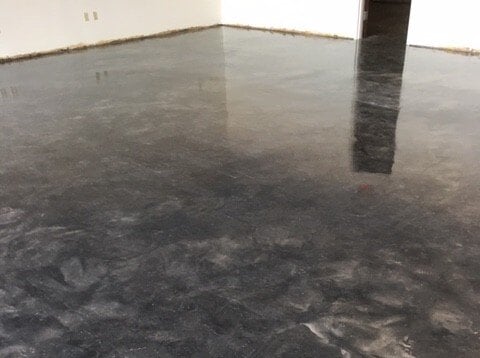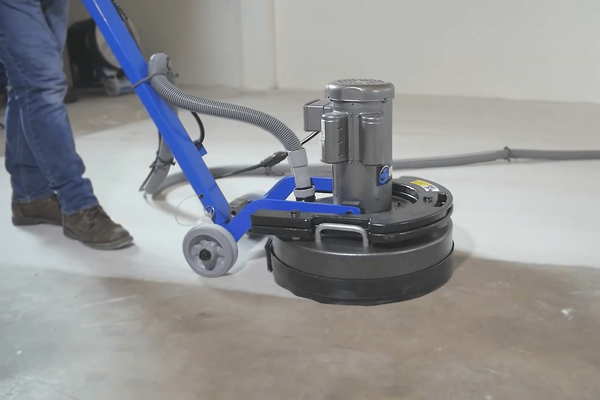Concrete has become an emergent flooring trend and for a good reason. The truth is fresh concrete is so much more than the gray, dull, industrial floors that used to line along plain and boring basement walls. In fact, it has already transitioned from the typical warehouse and garage floors to the modern industrial living space in residential homes.
Nonetheless, the idea of covering up concrete basement floors is still quite common, but it is not recommended. Covering your concrete basement floor with a different material can be detrimental to its longevity and condition. This is because the concrete needs exposure to air in order for it to breathe properly. When covered with rugs or carpet, the concrete will not be able to dry out and breathe, thus, this poor ventilation can lead to excess moisture build up which can result in a variety of problems such as mold growth and even structural damage.
What are Concrete Floors?
Concrete is a common subfloor because of its foundational durability and strength. It is extremely strong and can support heavy loads, making it ideal as basement floors, especially for storage space. In addition, a concrete surface is also extremely versatile and can be stained, painted, sealed or even have an epoxy coating added to it in order to create a unique and eye-catching finish.
Now, if you’re updating your flooring material, enhancing your concrete is one of the most economical and attractive options. This can be achieved by polishing and sealing your concrete floors, which will not only protect the floor but also give it a more attractive look.
WHY YOU SHOULDN'T USE FLOOR COVERINGS ON YOUR CONCRETE FLOOR
Covering your concrete basement floor with a different material is not recommended as it can be detrimental to its longevity and condition. Floor coverings, such as rugs or carpets, will trap moisture in the existing floor slab and prevent the concrete from drying out properly. This poor ventilation can cause mold growth and damage to the structure of your home.
Additionally, floor coverings can make it difficult to detect leaks in your basement, as the moisture that seeps through the concrete slabs will stay trapped underneath the floor covering. Over time, this pooling moisture can cause significant damage to your foundation walls, floors and even furniture stored in the area.
By choosing to leave your concrete basement floors exposed, you can avoid the potential dangers of trapping moisture underneath a floor covering. This way, you’ll also get to enjoy the natural beauty and durability of concrete floors in your home.
Nonetheless, it is still important to note that regular maintenance such as cleaning and sealing the surface should still be carried out in order to ensure long-lasting results.

WHY IS CONCRETE THE BEST OPTION FOR YOUR BASEMENT AND OTHER RESIDENTIAL FLOORING?
1. DURABILITY
Concrete is the most durable flooring on the market, which is why it’s often used as a subfloor or foundation. When polished and sealed, concrete can withstand all kinds of wear and tear. Concrete is stain-proof, weather-proof, waterproof, and scratch-proof. This makes it ideal for spaces with heavy furniture or storage.
Concrete is a great option if your space needs durable, strong floors that can withhold extensive wear.
2. LOW MAINTENANCE
Concrete is easy to clean and maintain. Polished and sealed concrete floors minimize dust, debris, stains, spills, and gunk. It’s also not susceptible to mold, mildew, or odors like other types of flooring. This significantly reduces maintenance energy and costs.
Because of its cleanliness, concrete is also a healthy option. It’s allergy -and pet-friendly, which keeps the space clean and clear for inhabitants.
How to maintain: Concrete requires weekly sweeping and mopping. You should also seal or wax concrete floors every 9 months for ongoing protection. Click here to learn how to effectively maintain polished concrete floors.
3. EASY REPAIRS
If something does happen to your concrete, which is rare, it’s easy and inexpensive to repair. Small cracks in concrete can be filled and leveled to appear as though there was never a fissure in the first place.
Learn how to repair cracked concrete here.
4. LONGEVITY
Ongoing maintenance and cleaning also help extend the lifespan of these durable floors. In fact, polished and maintained concrete can last for a century. Better yet, aged and cracked concrete actually looks better with age. This can drastically save your budget by not requiring multiple flooring installations.

5. TREND LONGEVITY
Concrete improves the value of your home over time because it ages beautifully. Concrete also never goes out of style. You’ll never be stuck with outdated floors, like shag carpets or neon tiles.
If you (or a future homeowner) decide you no longer want concrete, you can easily use that concrete as the subfloor for another type of flooring. Then, in the future, you can rip up that other flooring and return to concrete if you wish.
Concrete withstands time and trends.

6. versatility
Concrete can be used in just about any environment or situation. It works well indoors or outdoors and for home or commercial use. You can also use a variety of colors and textures to match just about any décor.
You can use concrete dyes, stains, or paints to color your concrete with just about any pigment you can imagine. Dyes create a more uniform look, while stains create a natural, variegated appearance.
You can also use texturing techniques like concrete stamps or decorative overlays. This allows your concrete to mimic other flooring designs, like hardwood, tile, or stone. In this way, you can have a natural look without the hefty expense and difficult maintenance of natural materials.
7. ENVIRONMENTAL
Concrete uses less energy to install than other flooring types. Its application generally has less chemical runoff into local water reserves. This is especially true if you use polishing and sealing as opposed to acid washes or stains.
Concrete also doesn’t deplete natural resources like marble, hardwood, or stone. You can make your concrete appear like these natural materials without actually pulling these resources from the environment. This makes it a more sustainable option for home renovations because you’re not using a new floor on top of the concrete subfloor.
It’s important to note, though, that pouring new concrete is not 100% eco-friendly. Concrete production releases a number of chemicals and greenhouse gases into the air. Still, it’s generally a more environmental choice than other flooring production, like tile or vinyl. Check out the most effective green flooring options by The Spruce.
8. ECONOMICAL
The cost of concrete is much lower than other flooring options. Polished concrete costs about $2 to $6 and more elaborate applications are $5 to $8 per square foot. The most expensive concrete is usually only up to $15 per square foot. Compare this to the average cost of hardwood at $17 per square foot or tile at $16 per square foot.
Plus, if your subfloor is already concrete, you save a significant amount on resources and installation. You then only have to pay for the concrete’s cleaning, staining/dying, and polishing/sealing. Some of these processes can even be done at home by even the most amateur flooring DIYers.
Check out the Onfloor blog for resources about at-home concrete applications.
WHAT ARE THE DRAWBACKS OF CONCRETE?
Despite concrete’s advantages and benefits, there are some concerns with concrete for certain spaces.
The greatest disadvantage is its hardness. Concrete is highly durable and scratch-proof, which helps the maintenance and longevity of your floors. However, if you drop something on concrete, that item is likely to break against the concrete’s sturdiness.
You also don’t want to stand on hard concrete floors for too long, as this can hurt your back and legs. Thus, a lot of people will avoid using concrete in kitchens or play areas. Concrete is more common in living rooms, basements, and outdoor spaces.
Concrete can also get cold, and it doesn’t circulate heat well. Some companies have started creating heated concrete mechanisms to offset this, so you can actually control the temperature of your floor underfoot. You can also use carpets or throw rugs to warm up the room and add a homey feel.
Concrete is susceptible to moisture unless waterproofed and sealed. If unsealed, water can seep into the pores of concrete to damage or stain the area. This moisture can also freeze, which can cause the floor to expand and crack.
Thus, you want to polish and seal floors on a consistent basis to protect against moisture changes. In some cases, you’ll want “grind and seal” concrete floors for ultimate durability and longevity.

BOTTOM LINE
Concrete’s beautiful design options, durability, eco-friendliness, and maintenance make it ideal for nearly any space in your home. It’s especially useful for basements, which generally require more durable and resistant flooring.
If you’re in the process of renovating your floors, consider saving time, money, and resources by rejuvenating your concrete subfloors. Best yet, you can update and re-update your concrete with new dyes and seals—so you can have refreshed concrete floors every few years!
Are you looking for a cost-effective floor renovation?
Let Onfloor help you update and enhance your concrete flooring.
Contact us now to start prepping your concrete to match the design of your home or business!
1 Comment